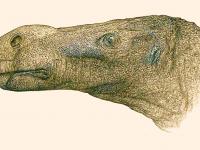Massospondylus
Wednesday, November 30, 2016

Massospondylus is a genus of sauropodomorph dinosaur from the Early Jurassic Period (Hettangian to Pliensbachian ages, ca. 200–183 million years ago). It was described by Sir Richard Owen in 1854 from remains discovered in South Africa, and is thus one of the first dinosaurs to have been named. Fossils have since been found at other locations in South Africa, Lesotho, and Zimbabwe.
Massospondylus was lightly built for a prosauropod, and much of its length was accounted for by its long neck and tail. Its body was similar in size to that of a large dog. The enlarged sickle-like thumb claws seen in other prosauropods were particularly well developed. We do not know exactly how Massospondylus used these huge claws. They would no doubt have made formidable weapons when the animal reared up on its hind legs to ward off predators-or perhaps to fight rival member of the species for mates. They may also have been useful in gathering food.

Although Massospondylus was long depicted as quadrupedal, a 2007 study found it to be bipedal. It was probably a plant eater (herbivore), although it is speculated that the early sauropodomorphs may have been omnivorous. This animal, which was 4–6 metres (13–20 ft) long, had a long neck and tail, with a small head and slender body. On each of its forefeet, it bore a sharp thumb claw that was used in defense or feeding. Recent studies indicate that Massospondylus grew steadily throughout its lifespan, possessed air sacs similar to those of birds, and may have cared for its young.
As with all dinosaurs, much of the biology of Massospondylus, including its behavior, coloration, and physiology, remains unknown. However, recent studies have allowed for informed speculation on subjects such as growth patterns, diet, posture, reproduction, and respiration








